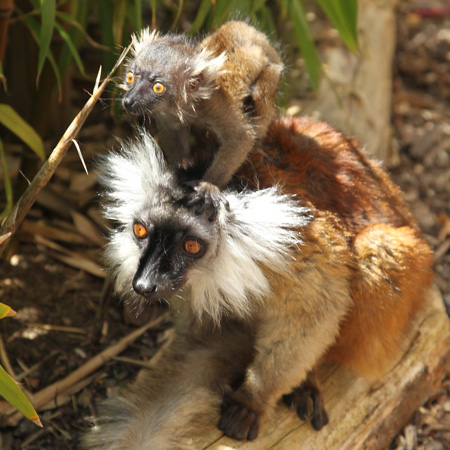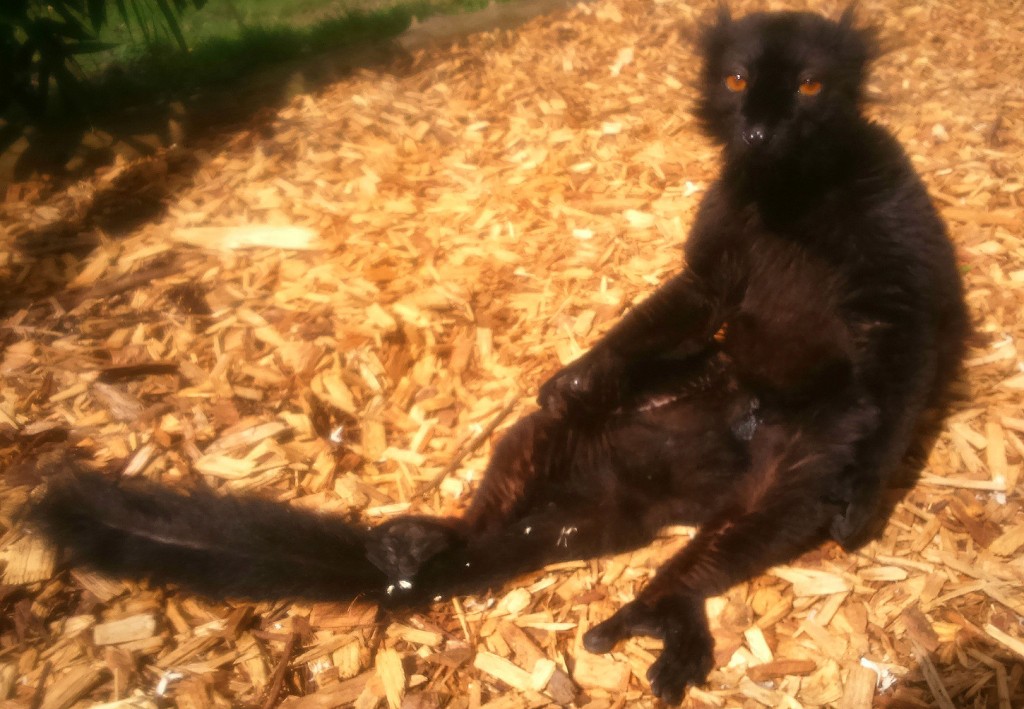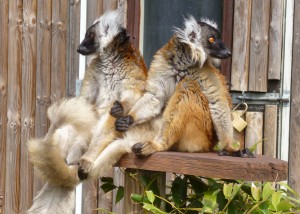Phil is a volunteer lemur keeper at the Howletts Wild Animal Park in the United Kingdom. He blogs for the Lemur Conservation Network about all things related to lemurs as well as the trials and tribulations of working in captive lemur management. Phil has visited rainforests of Bolivia, Thailand and Sumatra and completed a half-marathon in 2012 for slow lorises. 2015 is Phil’s Year of the Lemur. In March, he ran a half-marathon for greater bamboo lemurs and indris, raising £500 for the Aspinall Foundation. He will visit Madagascar in June.
A surprise addition – black lemurs

Say it quietly, but there may be a type of lemur that loves the sun even more than ring-tails and ruffed lemurs. They are loud, brash, territorial and at times a real pain to work with—black lemurs. Since late March I have been lucky and amused to be volunteering alongside Eulemur macaco, the troublemakers of the Howletts walk-through. Like our crowned lemurs they are a family of four but with an extremely different dynamic.
The intention was to create a prosimian utopia where crowned, red-bellied, ruffed and black lemurs live contently side by side—the twelve of them sharing meals and sunbathing spots, and taking turns pestering staff. The area is certainly big enough; I can truthfully say that the enclosure is among the best I’ve seen and a walk-through with four species would perhaps be unique. The black lemurs, though, had other ideas.

I have always enjoyed watching and listening to Howletts’ black lemurs. They are easily the most quirky of the four species we have. Therefore I was surprised yet elated to find them in the shed one morning. In the past I’ve known them only to eat, bask in the sun, bully the male, and emit constant grunts which are half duck, half pig. However, recent weeks have allowed me to study their characters and idiosyncrasies.
Unfortunately I wasn’t present for the introductions, but they didn’t go as planned. Of the four black lemurs three are female (whilst almost all lemurs are matriarchal, black lemur females seemingly rank far above the boys, or boy in our case). With opposing females in the crowned group, things didn’t look like settling down. Aramis the ruffed lemur was keen to defend his home too; that is, when the lure of the sun didn’t prove too much. The poor red bellies, our three timid fellows, took a back seat.
The hooligans of Howletts
Currently, the black lemurs get half the day in the walk-through and the peaceful, well behaved band get the other half. Their leader is without doubt Aprily – the mum and chief torturer of her partner Gasy. She chases him away aggressively at meal times before trying to swipe food from your hand.

She is a lady of contrasts, however. She has raised two daughters lovingly and takes every chance to laze in sunshine. Black lemurs may not do it in as cool a way as ring-tails and ruffed lemurs, but Aprily is trying her hardest. Like the others she sits vertically with her legs out-stretched, but also reclines horizontally like a human on a beach.
Gasy is the most recognisable – male black lemurs are black and the girls are brown. As mentioned, this species is incredibly matriarchal so even his daughters out-rank him. From watching him elsewhere in the park he seems to have spent much of his life being tormented, then left solo whilst the other three snuggle up to sleep. I have always thought ‘poor Gasy’ but his innocent looks hide the truth.
Gasy is the most interested in reaching the crowned lemurs. This is not to share grooming tips. I’ve also been told that in his old location in the park he didn’t take kindly to wild birds entering the area. He seems happier these days though, he still has to sunbathe on the floor but the new sights and sounds have reduced how much he himself gets harassed. At meal times we ensure he gets some sweet stuff too, rather than leftover vegetables.
There are two children, Valyha and Kintana who are two and three respectively. Kintana appears closer to her dad and is more outgoing than her sister. They are the best mannered of the quartet, not that that means much. Collectively the four of them are constantly hunting mischief, following guests, and never shut up.
No Rest for the Wicked
When outside, it is the black lemurs in charge of the vicinity, not me. A child has a flower? Maybe a cuddly toy? Let’s crowd around and try to steal it. Wheelchair? That’s intriguing. And I can’t smell food in that bag, but just in case, I’m going to stalk the person and pull on it.

Gasy is the main culprit but no one is blameless. I am frequently laughing and having to coerce them away from unsuspecting visitors. As walk-through animals, they are lots of fun and highly photogenic. I also have this position thanks to them; last year I visited just to listen to their duck grunts and put it on Youtube. That’s when I saw the ‘help wanted’ sign.
They don’t only grunt though – black lemurs can scream. The best way I can describe it is that it reminds me of the Lost Boys’ call in the 90s film ‘Hook’. One crows and the others echo the cry. It’s not menacing or threatening; they simply appear to be excited.
I’m positive I still have lots to learn from Aprily and company. That is if they don’t all get me in trouble soon. I really do hope that another baby is born this year and Gasy finally gets some male company to teach his tricks. He deserves a break from his high maintenance females.
Biology of black lemurs
Black lemurs live in primary and secondary forest in north Madagascar. They have a small range but are more adaptable than many other lemurs. This has meant that they are only considered ‘vulnerable’, which is better than most of their cousins across the country.
Group size ranges from two to fifteen. Females are able to become pregnant from two onwards, meaning both Kintana and Valyha are mature. Mating takes place around now with one young born roughly 125 days later.
What black lemurs eat
Whilst our four relish a healthy cocktail of exotic and domestic fruit plus vegetables, wild ones feed on fruits for eleven months of the year. In that barren month, attention turns to leaves, flowers, bark, mushroom and insects.
Most food will be found in the middle and upper canopy – they are very important in seed dispersal! Being cathemeral (active at all times) like other true lemurs, they feast in daytime in the understorey before moving to the tree tops at night. This keeps them safe from predatory birds.
Threats to black lemurs
Whilst they are able to avoid raptors, sadly there is no escape from deforestation. They are also regrettably popular as pets and bushmeat, and are persecuted for raiding crops.
Black lemurs and millipedes
Wild black lemurs have also been recorded doing something distinctive; they bite into millipedes and use their toxins as an insect repellent. However, this has other effects…
If Gasy and company ever find a millipede, I’ll be sure to report back.
Take Action
Phil volunteers at the Howletts Wild Animal Park, which is run by the Aspinall Foundation, a member of the Lemur Conservation Network.

